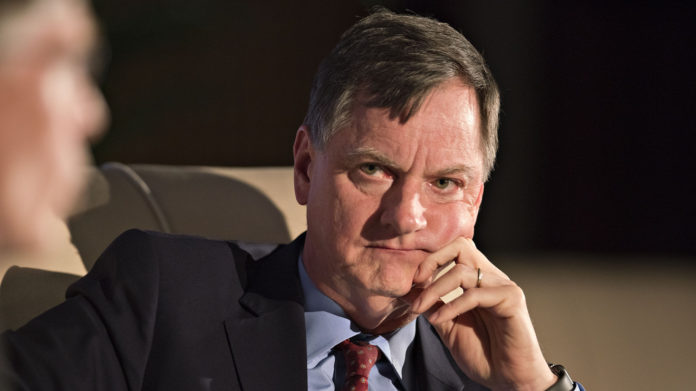The U.S. economy may return to growth in the second half of the year as businesses open up again after the lockdowns to combat the coronavirus pandemic, but more pessimistic scenarios are almost as likely, Chicago Fed President Charles Evans said Tuesday.
The baseline scenario “involves a lot of things going right,” he said. The economy, he predicts, would hit a double-digit unemployment rate but this would come down gradually to near 5% by the end of 2021.
“I hate to say this but at this still early stage the likelihood of the baseline scenario may only be a bit higher than that of the more pessimistic possibilities,” Evans told reporters during a conference call on Tuesday.
During the call, Evans said it was too soon to say what monetary policy would best help the economy recover.
He said the Fed’s benchmark interest rate would stay low for quite some time.
There was some reason to hope as some businesses have already been able to adapt to new social distancing measures, Evans said.
The Fed has cut its benchmark interest rate to zero and said it intends to hold rates steady until the economy makes progress to returning to full employment and 2% inflation.
Asked about the possible need for stronger forward guidance, Evans said the central bank had time to sit back and see how things develop.
“I don’t think there’s a need for guidance at the moment because I can’t imagine that anybody is expecting the Fed to raise the interest rates over any relevant time horizon,” Evans said.
In a separate interview, St. Louis Fed President James Bullard said that he thought the Fed’s benchmark interest rate would stay near zero for “years” not “months.”
If the market got worried that the Fed wouldn’t be so accommodative, “we’d have to be much clearer,” he added.
“At the moment, the path of the economy is not yet clear,” Evans said. The summer months will help clear up the outlook, he said.
Evans also said he thought disinflation was more likely than inflation in coming months.
Once the Fed sees a path forward, Evans said he expects the Fed would continue to buy Treasurys and mortgage-backed securities and could also cap interest rates beyond short-term rates, a policy known as yield curve control.
This week, about half of the U.S. states have begun to reopen their economies.
Evans said he thought this reopening was “a bold decision, with pretty high risks.”
“We will learn something from these experiments,” including about how much consumers are willing to return to stores, he said.
“We’re all anxious to know more about how this is going to work out. This summer, I think we’re have a better idea. I think individuals willingness to wear masks out in public when they are interacting with people…will be very important,” he said.
Bullard said it was a good thing to get away from a blanket nationwide stay-at-home policy, because if it lasted longer than 90 days it would cause severe problems for the economy.
“I think the shutdown is not a one-size-fits-all policy,” Bullard said.
But as time goes on, this is a mortality risk that we have to get used to dealing with,” he said.
Bullard has called for a “saturation” of testing so people will know what they are interacting with, he said.
Bullard said the April-June quarter will be the worst, with the unemployment rate possibly already above 20%. The third quarter will be a “transition” period and “by the time we get to the fourth quarter I would hope that you could have an end to the crisis and put this behind us,” he said.
U.S. equity benchmarks closed higher Tuesday. The S&P 500 index
SPX,
was up 25.70 points, or 0.9% to end at 2,868.44.
Source : MTV












